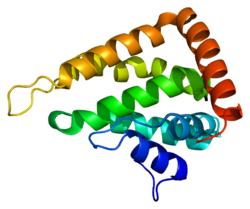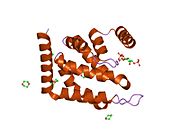Protein-coding gene in the species Homo sapiens
| EPN1 |
|---|
 |
| Available structures |
|---|
| PDB | Ortholog search: PDBe RCSB |
|---|
|
|
| Identifiers |
|---|
| Aliases | EPN1, epsin 1 |
|---|
| External IDs | OMIM: 607262; MGI: 1333763; HomoloGene: 32172; GeneCards: EPN1; OMA:EPN1 - orthologs |
|---|
| Gene location (Human) |
|---|
 | | Chr. | Chromosome 19 (human)[1] |
|---|
| | Band | 19q13.42 | Start | 55,675,226 bp[1] |
|---|
| End | 55,709,858 bp[1] |
|---|
|
| Gene location (Mouse) |
|---|
 | | Chr. | Chromosome 7 (mouse)[2] |
|---|
| | Band | 7|7 A1 | Start | 5,080,235 bp[2] |
|---|
| End | 5,098,178 bp[2] |
|---|
|
| RNA expression pattern |
|---|
| Bgee | | Human | Mouse (ortholog) |
|---|
| Top expressed in | - apex of heart
- body of stomach
- mucosa of transverse colon
- right frontal lobe
- right auricle
- anterior cingulate cortex
- left testis
- muscle of thigh
- right testis
- body of pancreas
|
| | Top expressed in | - Ileal epithelium
- perirhinal cortex
- CA3 field
- entorhinal cortex
- primary visual cortex
- superior frontal gyrus
- dentate gyrus of hippocampal formation granule cell
- lactiferous gland
- choroid plexus of fourth ventricle
- ankle joint
|
| | More reference expression data |
|
|---|
| BioGPS | |
|---|
|
| Gene ontology |
|---|
| Molecular function | - protein binding
- lipid binding
| | Cellular component | - cytoplasm
- plasma membrane
- clathrin-coated pit
- membrane
- nucleus
- cytosol
| | Biological process | - Notch signaling pathway
- female pregnancy
- negative regulation of epidermal growth factor receptor signaling pathway
- in utero embryonic development
- endocytosis
- embryonic organ development
- membrane organization
- negative regulation of sprouting angiogenesis
| | Sources:Amigo / QuickGO |
|
| Orthologs |
|---|
| Species | Human | Mouse |
|---|
| Entrez | | |
|---|
| Ensembl | | |
|---|
| UniProt | | |
|---|
| RefSeq (mRNA) | |
|---|
NM_001130071
NM_001130072
NM_013333
NM_001321263 |
| |
|---|
| RefSeq (protein) | |
|---|
NP_001123543
NP_001123544
NP_001308192
NP_037465 |
| |
|---|
NP_001239383
NP_034277
NP_001359429 |
|
|---|
| Location (UCSC) | Chr 19: 55.68 – 55.71 Mb | Chr 7: 5.08 – 5.1 Mb |
|---|
| PubMed search | [3] | [4] |
|---|
|
| Wikidata |
| View/Edit Human | View/Edit Mouse |
|
Epsin-1 is a protein that in humans is encoded by the EPN1 gene.[5][6][7]
EPN1 is an endocytic accessory protein that interacts with EPS15 (MIM 600051), the alpha subunit of the clathrin adaptor AP2 (AP2A1; MIM 601026), and clathrin (see MIM 118960), as well as with other accessory proteins for the endocytosis of clathrin-coated vesicles.[supplied by OMIM][7]
Interactions
EPN1 has been shown to interact with REPS2,[6] AP2A2[5] and EPS15.[5]
References
- ^ a b c GRCh38: Ensembl release 89: ENSG00000063245 – Ensembl, May 2017
- ^ a b c GRCm38: Ensembl release 89: ENSMUSG00000035203 – Ensembl, May 2017
- ^ "Human PubMed Reference:". National Center for Biotechnology Information, U.S. National Library of Medicine.
- ^ "Mouse PubMed Reference:". National Center for Biotechnology Information, U.S. National Library of Medicine.
- ^ a b c Chen H, Fre S, Slepnev VI, Capua MR, Takei K, Butler MH, Di Fiore PP, De Camilli P (Sep 1998). "Epsin is an EH-domain-binding protein implicated in clathrin-mediated endocytosis". Nature. 394 (6695): 793–7. Bibcode:1998Natur.394..793C. doi:10.1038/29555. PMID 9723620. S2CID 4430975.
- ^ a b Morinaka K, Koyama S, Nakashima S, Hinoi T, Okawa K, Iwamatsu A, Kikuchi A (Dec 1999). "Epsin binds to the EH domain of POB1 and regulates receptor-mediated endocytosis". Oncogene. 18 (43): 5915–22. doi:10.1038/sj.onc.1202974. PMID 10557078.
- ^ a b "Entrez Gene: EPN1 epsin 1".
Further reading
- Drake MT, Downs MA, Traub LM (2000). "Epsin binds to clathrin by associating directly with the clathrin-terminal domain. Evidence for cooperative binding through two discrete sites" (PDF). J. Biol. Chem. 275 (9): 6479–89. doi:10.1074/jbc.275.9.6479. PMID 10692452. S2CID 22584410.
- Kariya K, Koyama S, Nakashima S, et al. (2000). "Regulation of complex formation of POB1/epsin/adaptor protein complex 2 by mitotic phosphorylation". J. Biol. Chem. 275 (24): 18399–406. doi:10.1074/jbc.M000521200. PMID 10764745.
- Hyman J, Chen H, Di Fiore PP, et al. (2000). "Epsin 1 Undergoes Nucleocytosolic Shuttling and Its Eps15 Interactor Nh2-Terminal Homology (Enth) Domain, Structurally Similar to Armadillo and Heat Repeats, Interacts with the Transcription Factor Promyelocytic Leukemia Zn2+ Finger Protein (Plzf)". J. Cell Biol. 149 (3): 537–46. doi:10.1083/jcb.149.3.537. PMC 2174850. PMID 10791968.
- Drake MT, Traub LM (2001). "Interaction of two structurally distinct sequence types with the clathrin terminal domain beta-propeller". J. Biol. Chem. 276 (31): 28700–9. doi:10.1074/jbc.M104226200. PMID 11382783.
- Ford MG, Mills IG, Peter BJ, et al. (2002). "Curvature of clathrin-coated pits driven by epsin". Nature. 419 (6905): 361–6. Bibcode:2002Natur.419..361F. doi:10.1038/nature01020. PMID 12353027. S2CID 4372368.
- Strausberg RL, Feingold EA, Grouse LH, et al. (2003). "Generation and initial analysis of more than 15,000 full-length human and mouse cDNA sequences". Proc. Natl. Acad. Sci. U.S.A. 99 (26): 16899–903. Bibcode:2002PNAS...9916899M. doi:10.1073/pnas.242603899. PMC 139241. PMID 12477932.
- Koshiba S, Kigawa T, Kikuchi A, Yokoyama S (2003). "Solution structure of the epsin N-terminal homology (ENTH) domain of human epsin". J. Struct. Funct. Genomics. 2 (1): 1–8. doi:10.1023/A:1011397007366. PMID 12836669. S2CID 13317798.
- Ota T, Suzuki Y, Nishikawa T, et al. (2004). "Complete sequencing and characterization of 21,243 full-length human cDNAs". Nat. Genet. 36 (1): 40–5. doi:10.1038/ng1285. PMID 14702039.
- Gerhard DS, Wagner L, Feingold EA, et al. (2004). "The Status, Quality, and Expansion of the NIH Full-Length cDNA Project: The Mammalian Gene Collection (MGC)". Genome Res. 14 (10B): 2121–7. doi:10.1101/gr.2596504. PMC 528928. PMID 15489334.
- Timsit YE, Miller SL, Mohney RP, O'Bryan JP (2005). "The U-box ligase carboxyl-terminus of Hsc 70-interacting protein ubiquitylates Epsin". Biochem. Biophys. Res. Commun. 328 (2): 550–9. doi:10.1016/j.bbrc.2005.01.022. PMID 15694383.
- Schmid EM, Ford MG, Burtey A, et al. (2007). "Role of the AP2 β-Appendage Hub in Recruiting Partners for Clathrin-Coated Vesicle Assembly". PLOS Biol. 4 (9): e262. doi:10.1371/journal.pbio.0040262. PMC 1540706. PMID 16903783.
- Olsen JV, Blagoev B, Gnad F, et al. (2006). "Global, in vivo, and site-specific phosphorylation dynamics in signaling networks". Cell. 127 (3): 635–48. doi:10.1016/j.cell.2006.09.026. PMID 17081983. S2CID 7827573.
PDB gallery
-
1edu: CRYSTAL STRUCTURE OF THE ENTH DOMAIN OF RAT EPSIN 1 -
1eyh: CRYSTAL STRUCTURE OF THE EPSIN N-TERMINAL HOMOLOGY (ENTH) DOMAIN AT 1.56 ANGSTROM RESOLUTION -
1h0a: EPSIN ENTH BOUND TO INS(1,4,5)P3 -
1inz: SOLUTION STRUCTURE OF THE EPSIN N-TERMINAL HOMOLOGY (ENTH) DOMAIN OF HUMAN EPSIN |
 | This article on a gene on human chromosome 19 is a stub. You can help Wikipedia by expanding it. |

 1edu: CRYSTAL STRUCTURE OF THE ENTH DOMAIN OF RAT EPSIN 1
1edu: CRYSTAL STRUCTURE OF THE ENTH DOMAIN OF RAT EPSIN 1 1eyh: CRYSTAL STRUCTURE OF THE EPSIN N-TERMINAL HOMOLOGY (ENTH) DOMAIN AT 1.56 ANGSTROM RESOLUTION
1eyh: CRYSTAL STRUCTURE OF THE EPSIN N-TERMINAL HOMOLOGY (ENTH) DOMAIN AT 1.56 ANGSTROM RESOLUTION 1h0a: EPSIN ENTH BOUND TO INS(1,4,5)P3
1h0a: EPSIN ENTH BOUND TO INS(1,4,5)P3 1inz: SOLUTION STRUCTURE OF THE EPSIN N-TERMINAL HOMOLOGY (ENTH) DOMAIN OF HUMAN EPSIN
1inz: SOLUTION STRUCTURE OF THE EPSIN N-TERMINAL HOMOLOGY (ENTH) DOMAIN OF HUMAN EPSIN



















